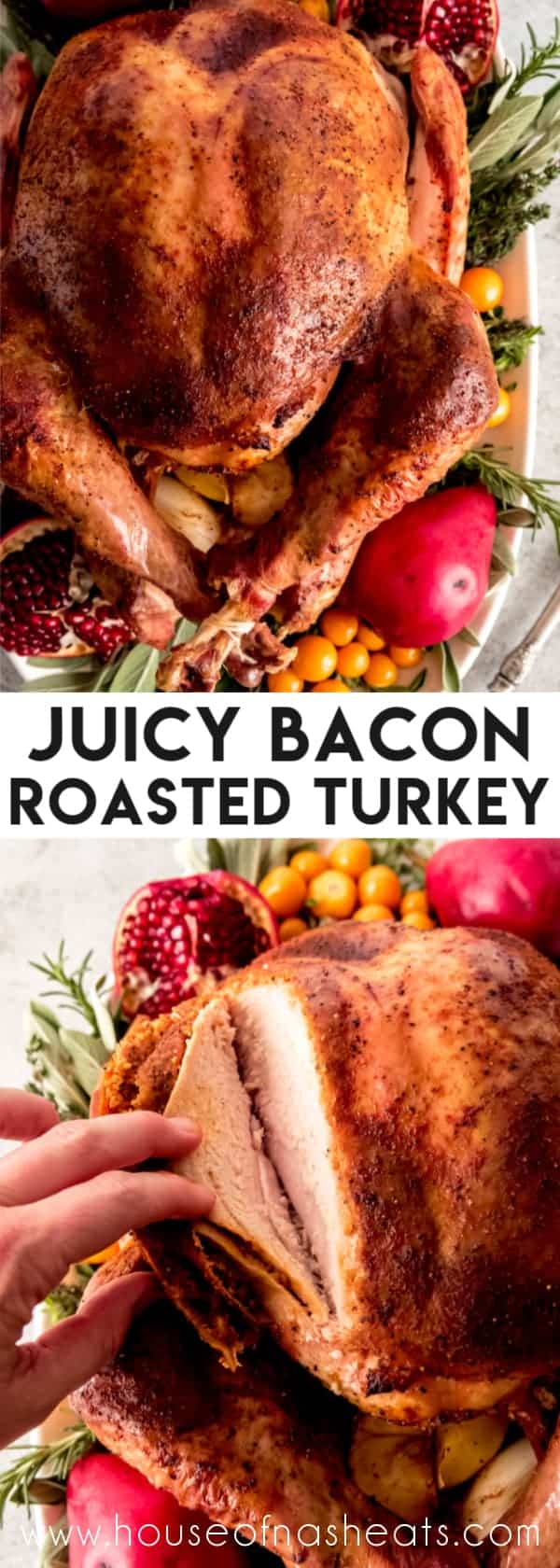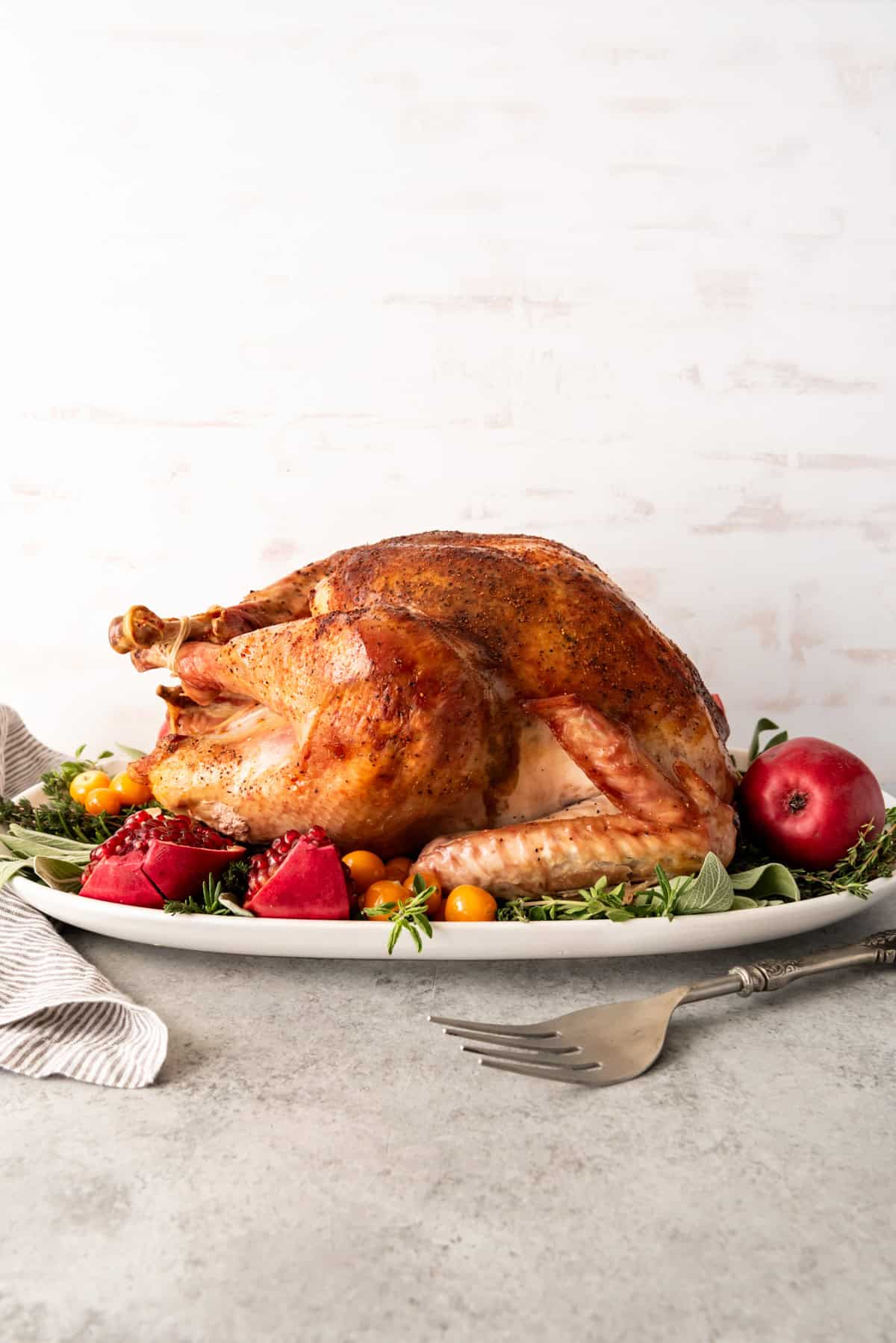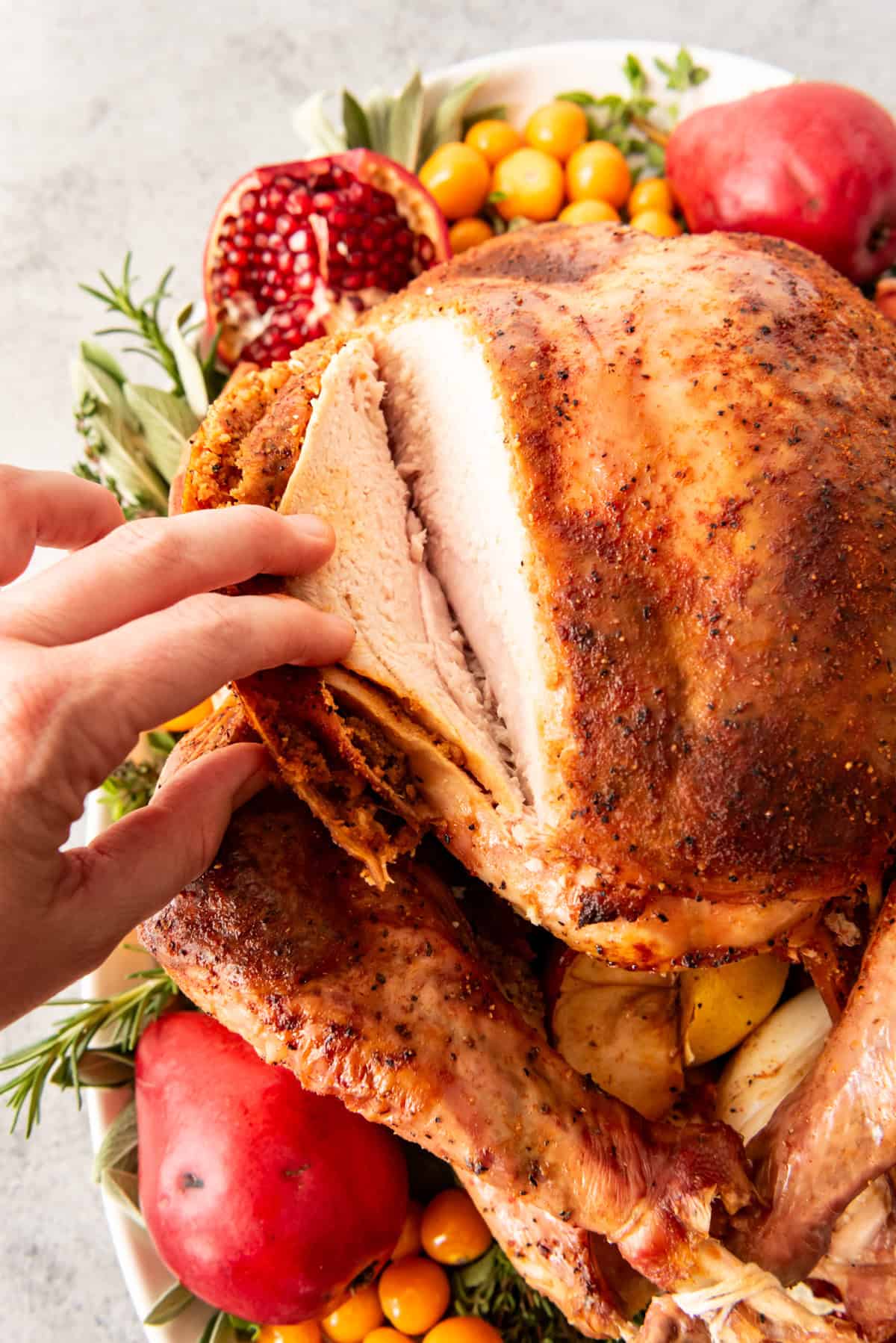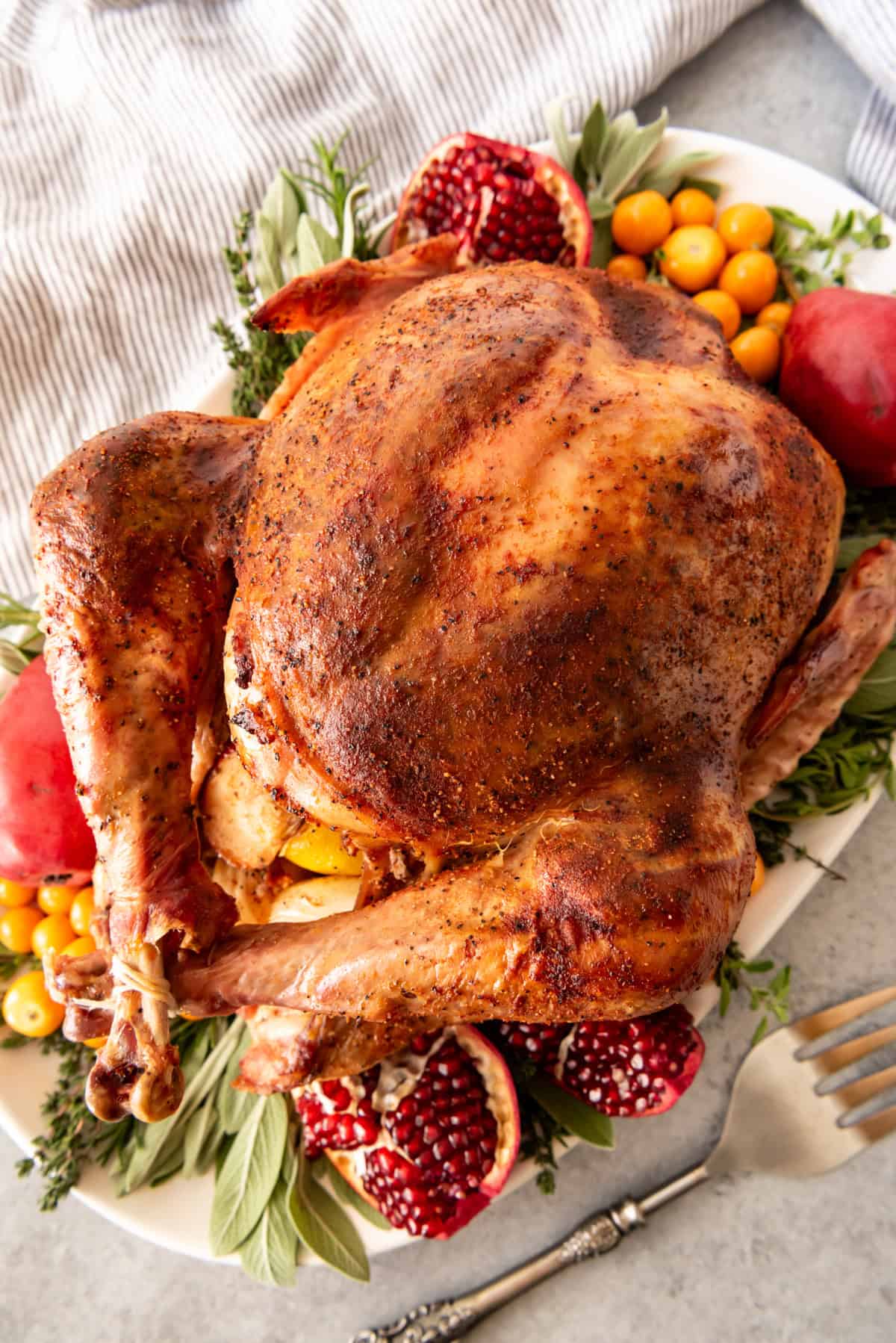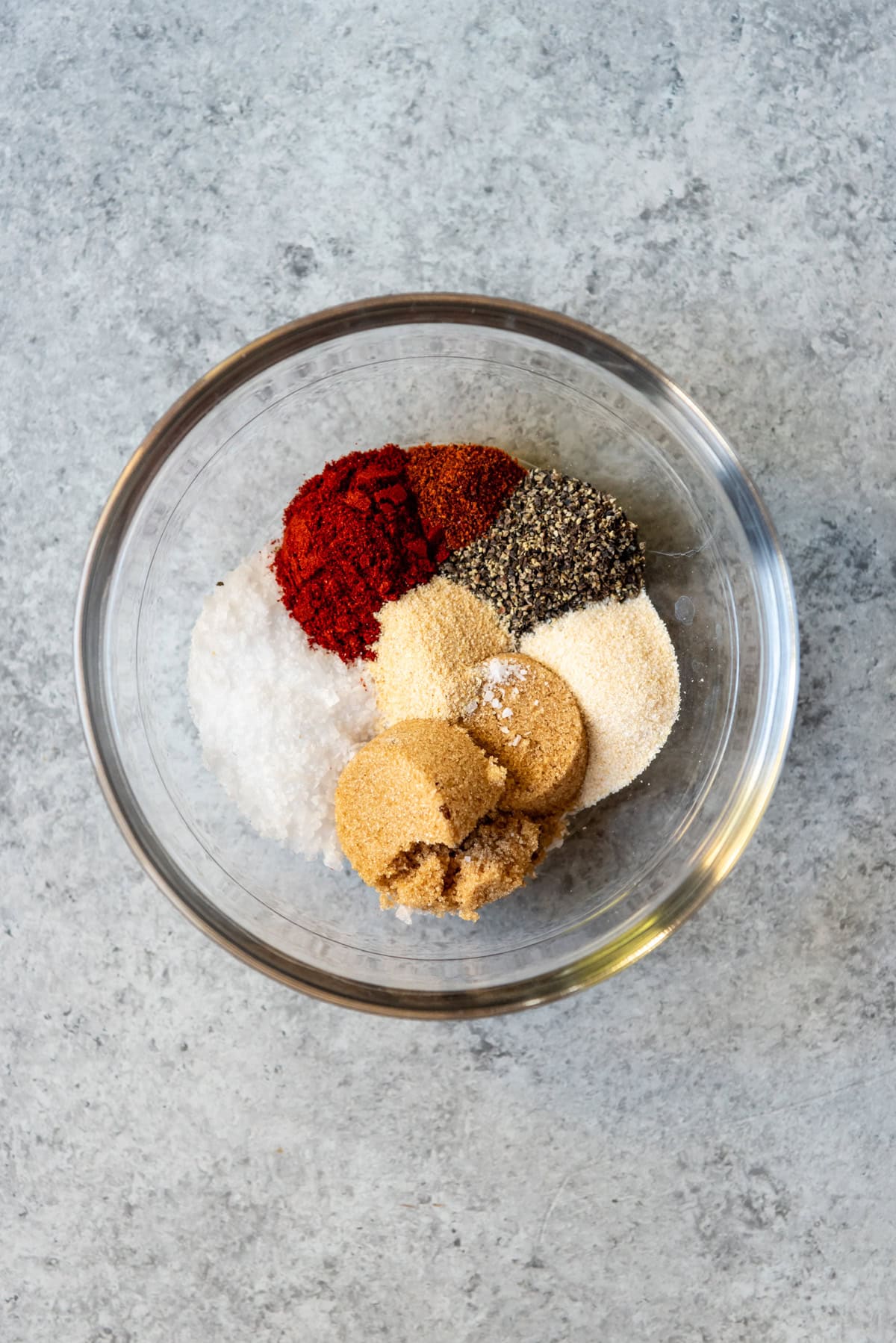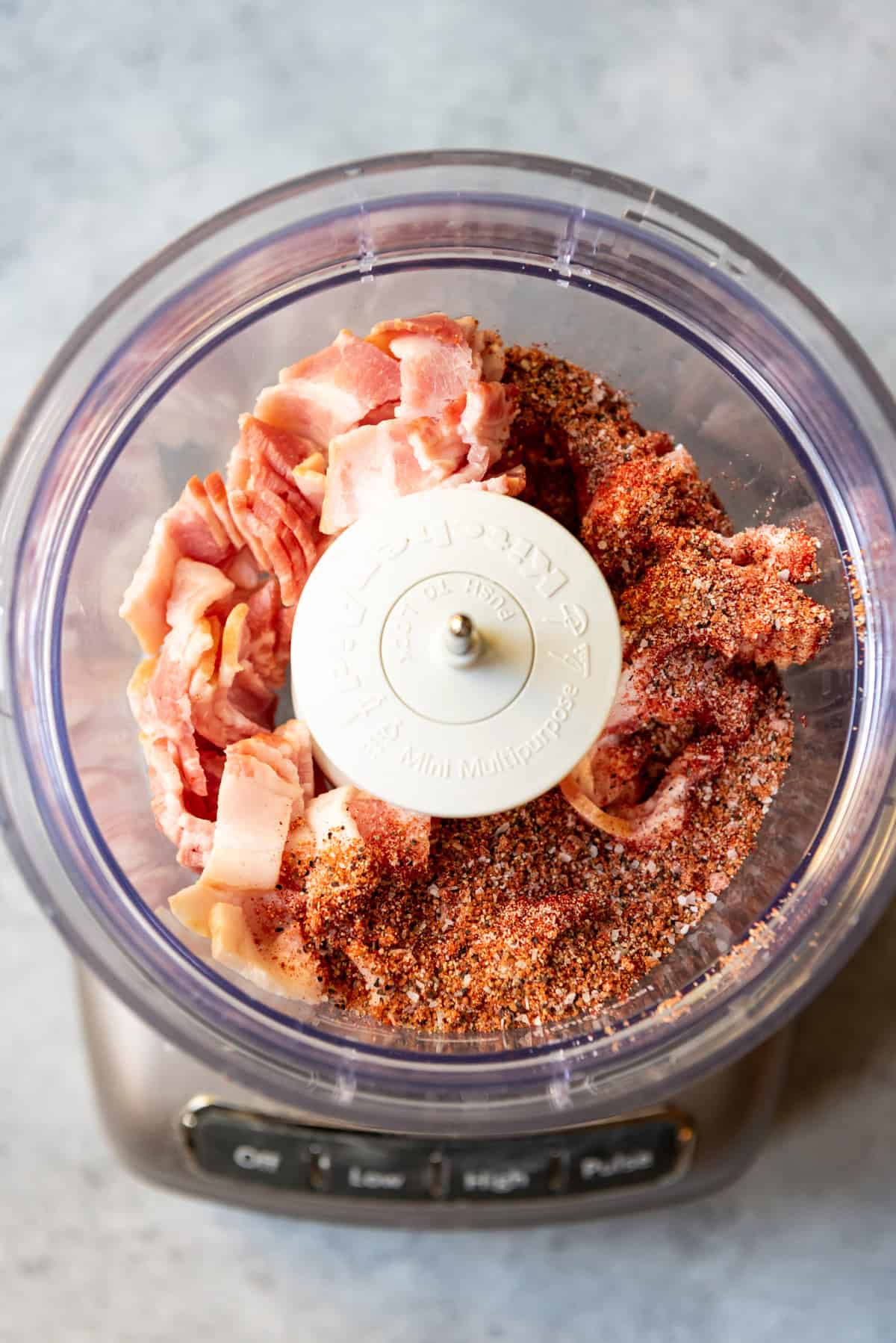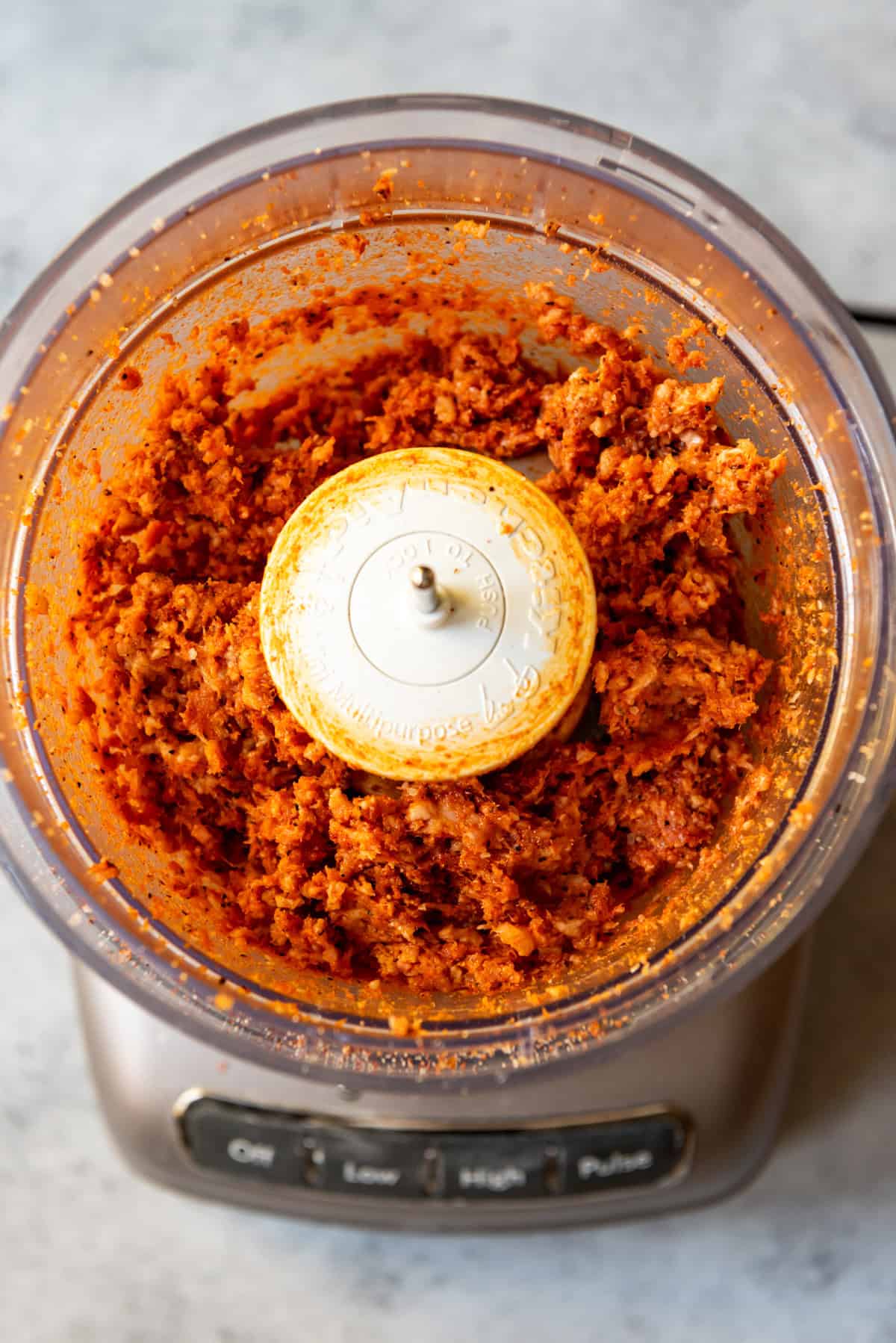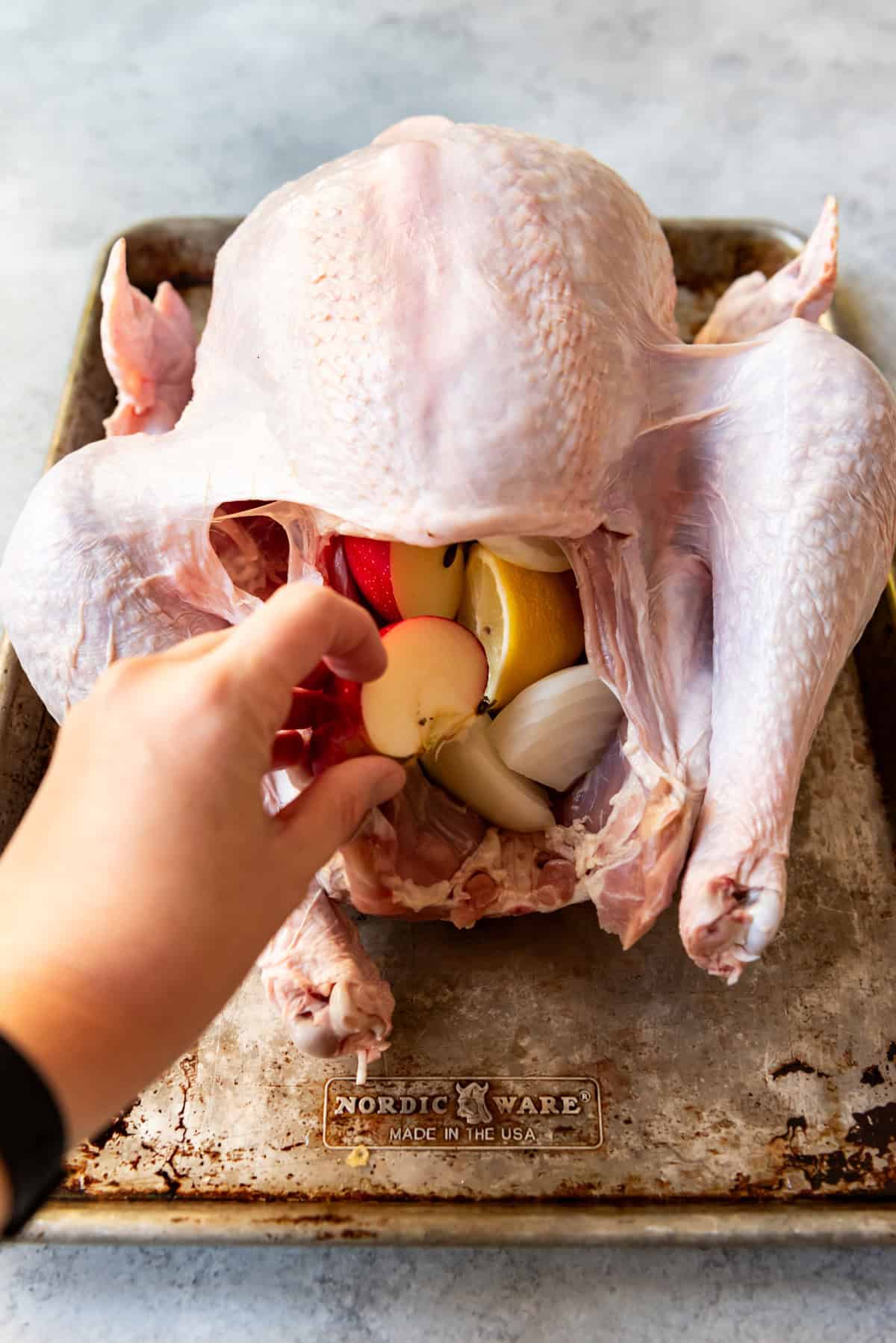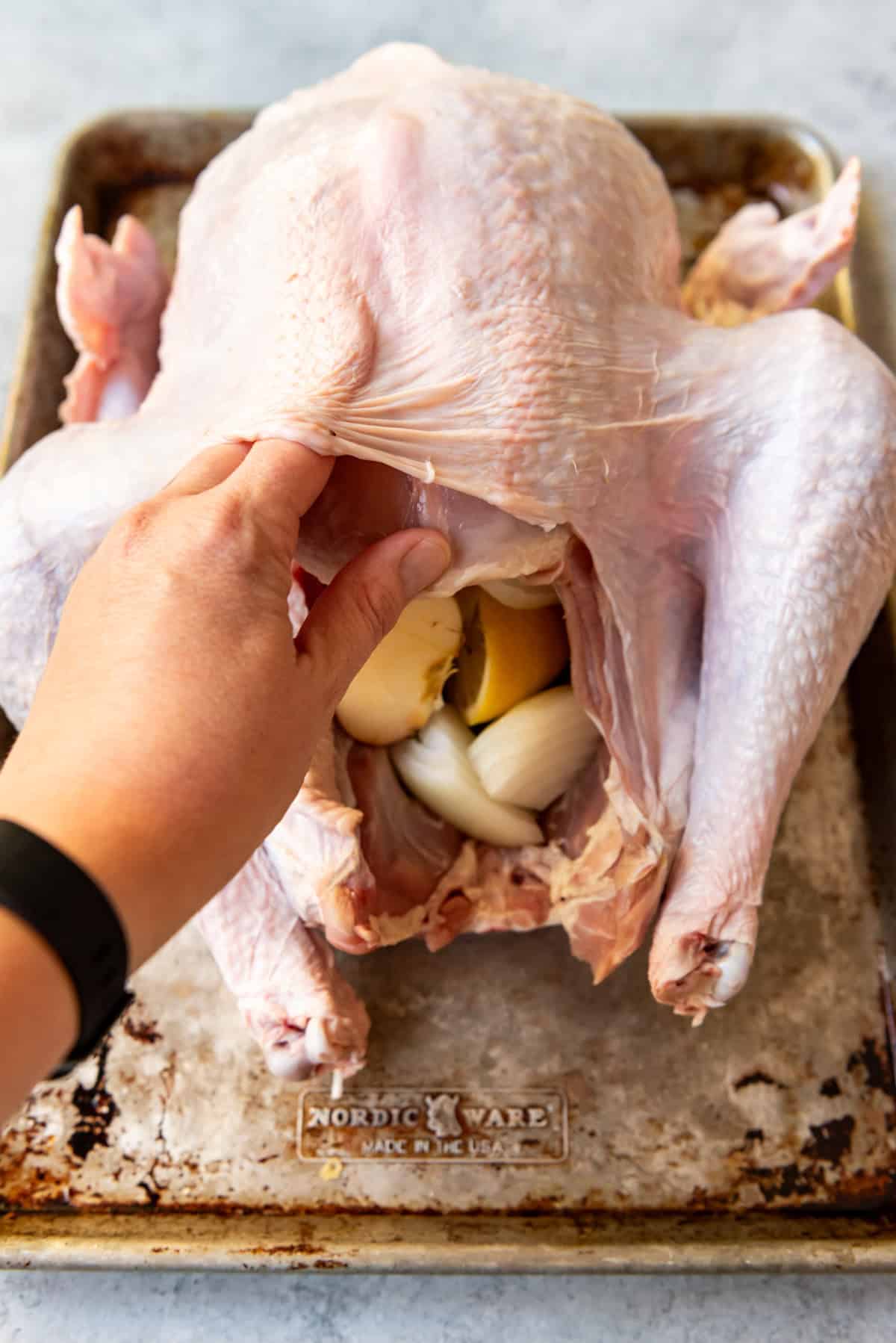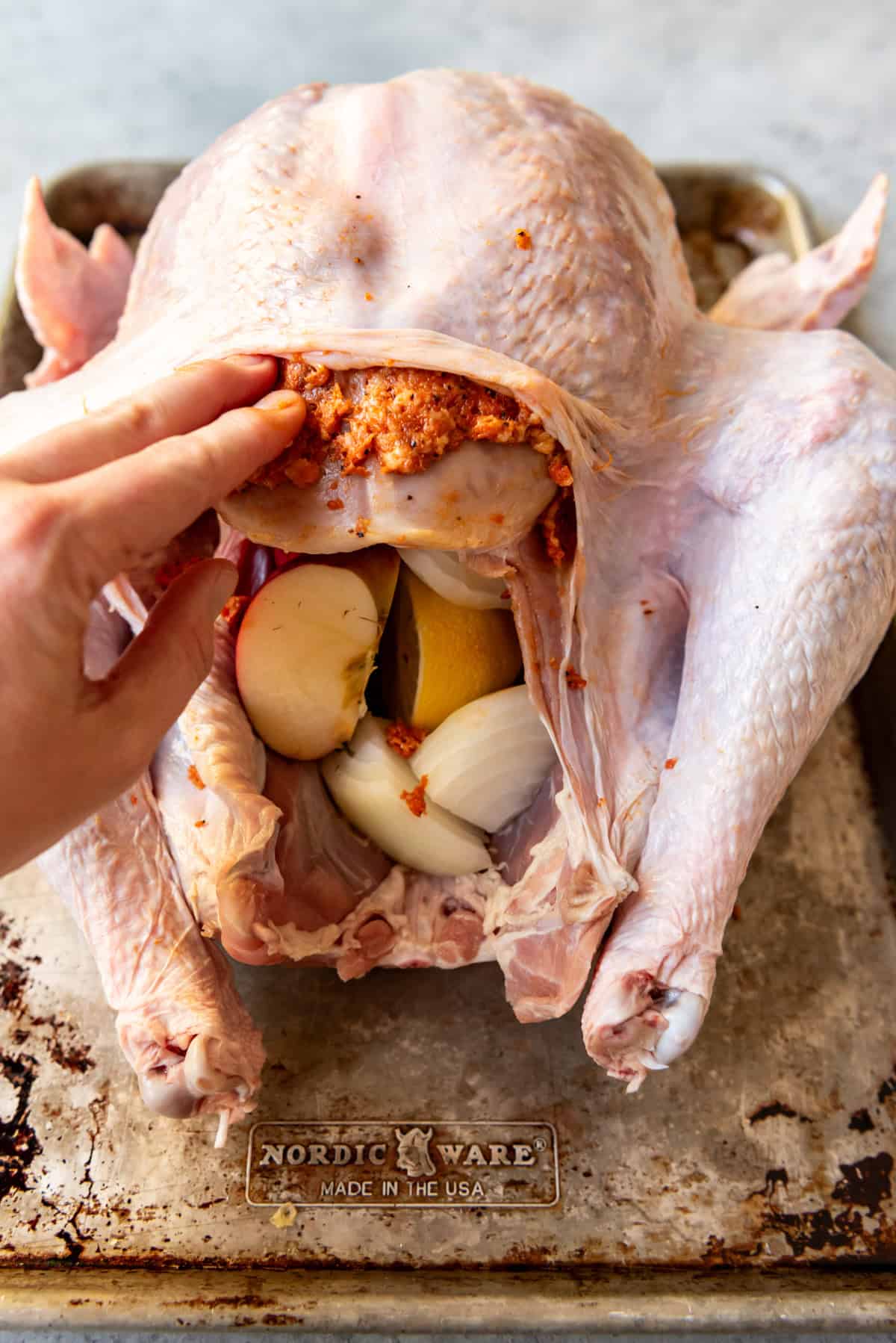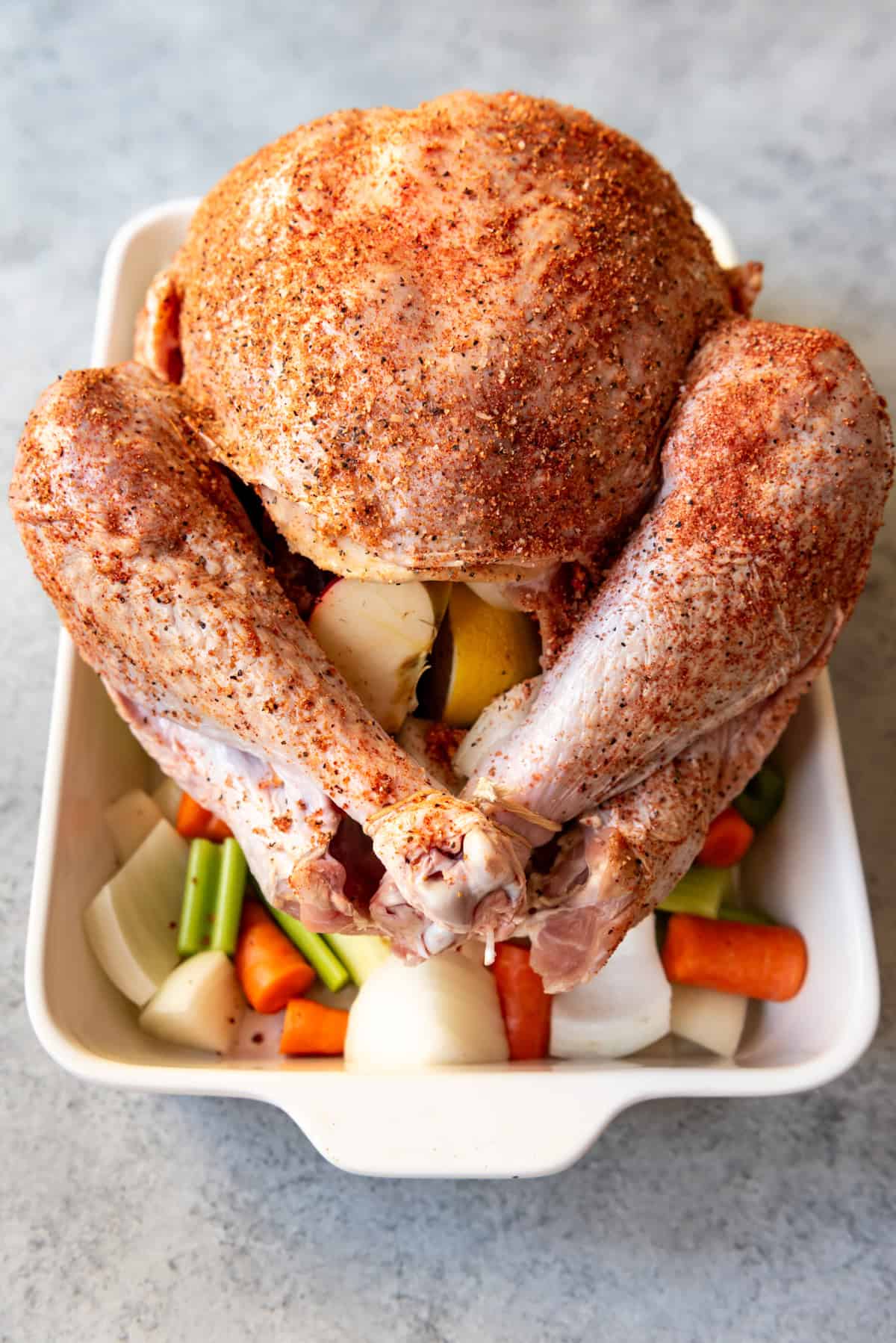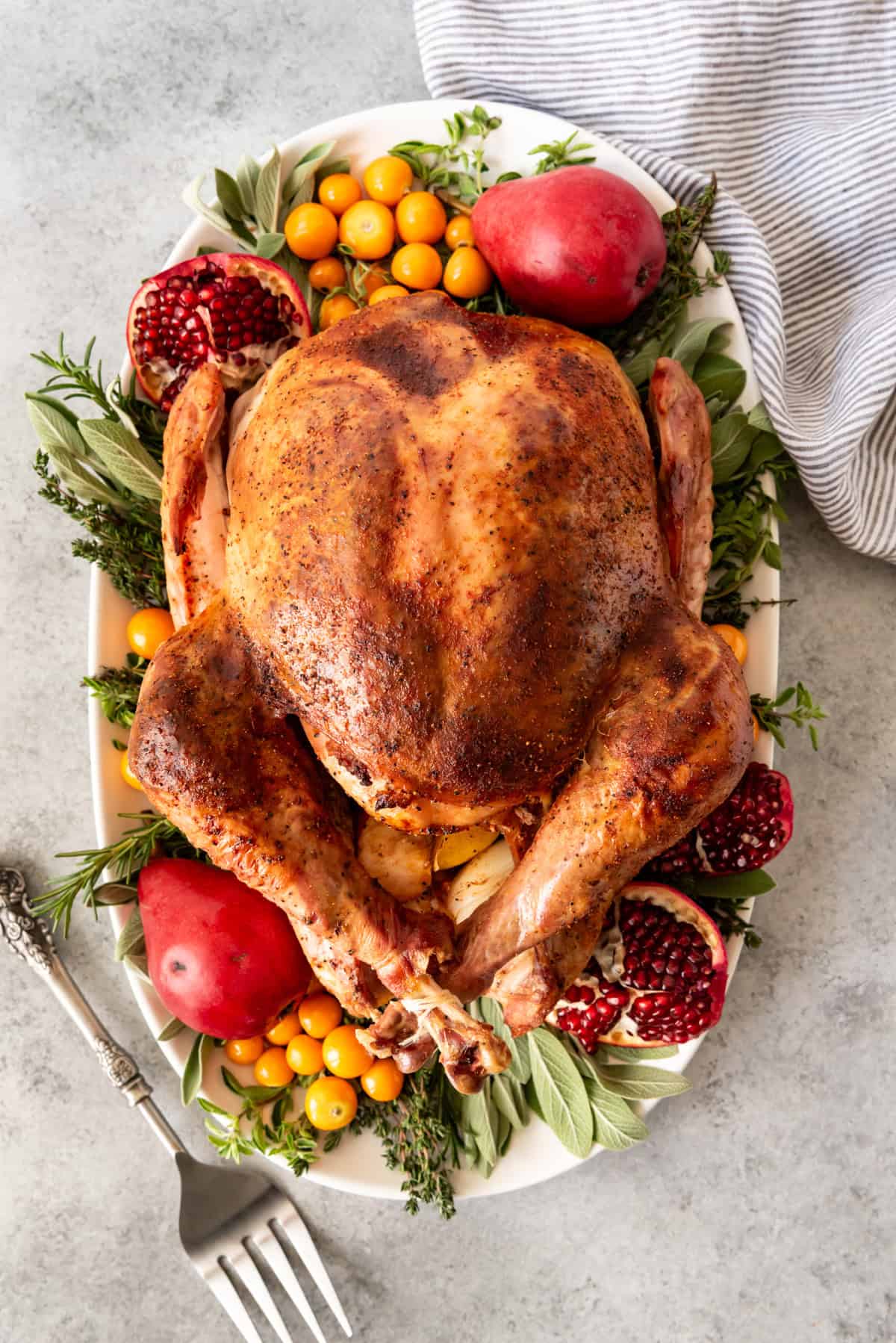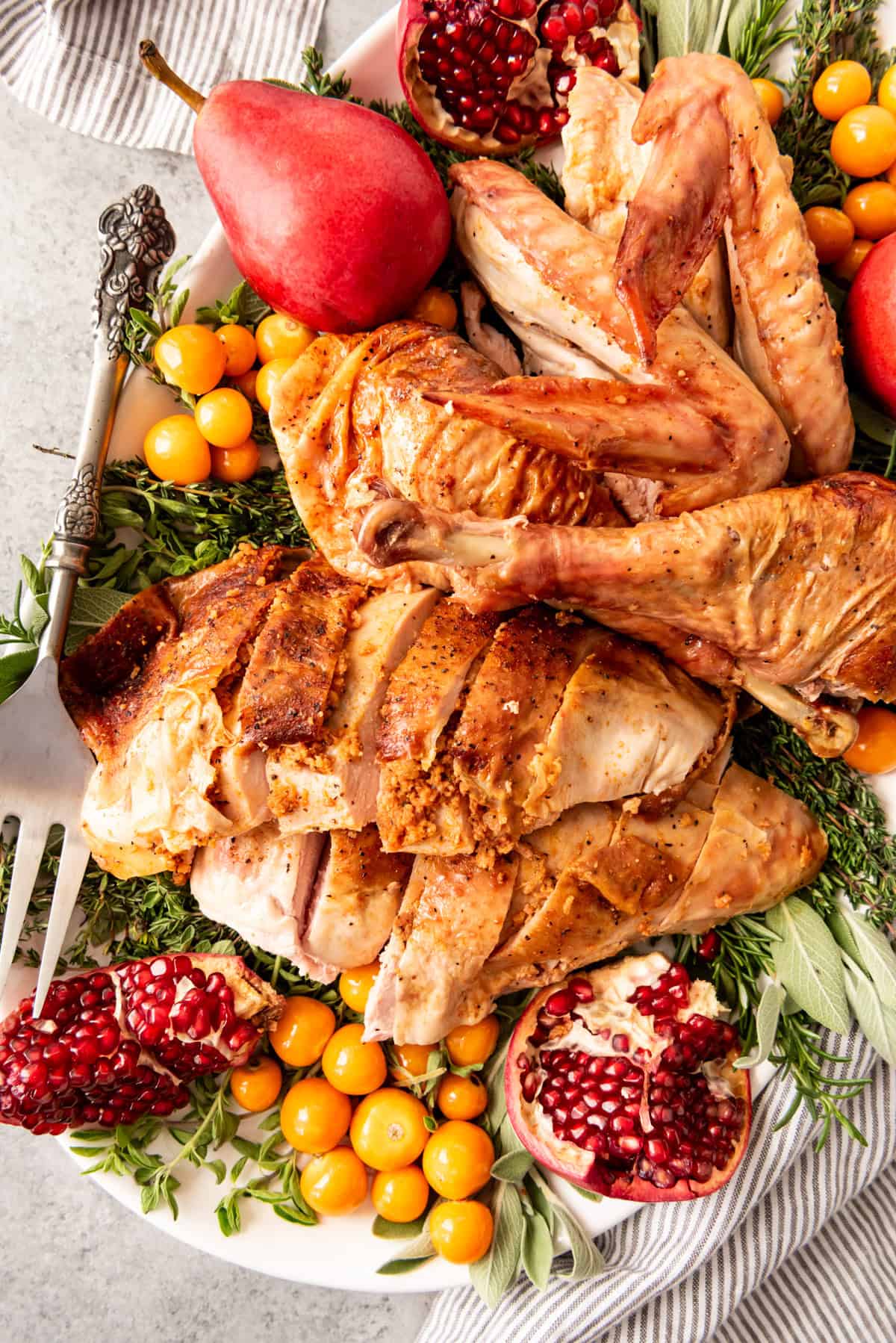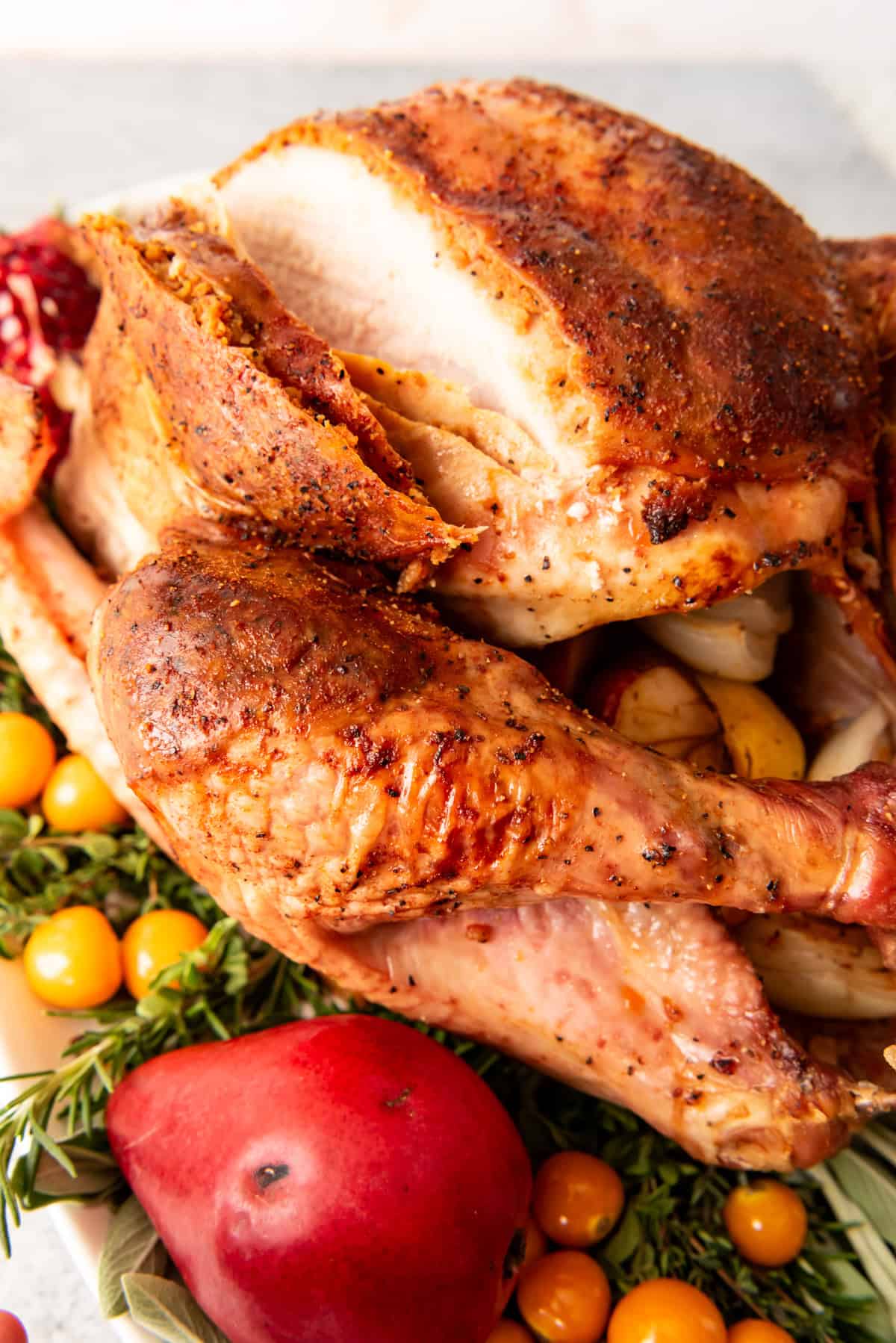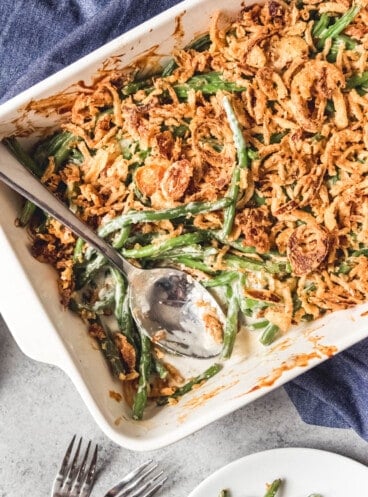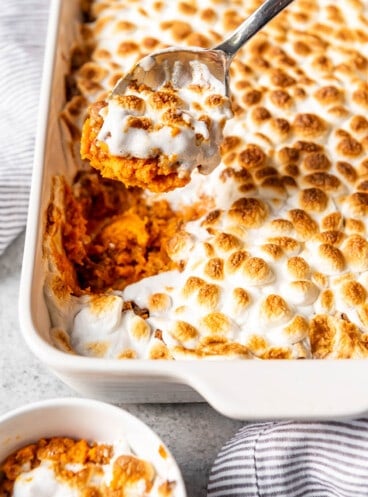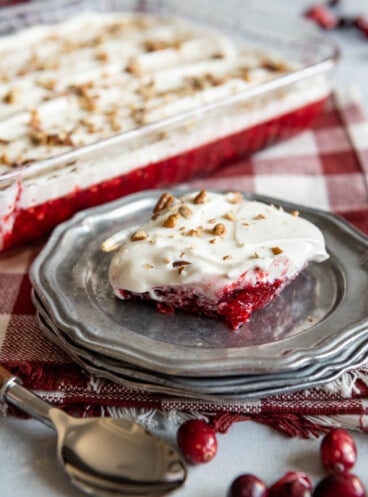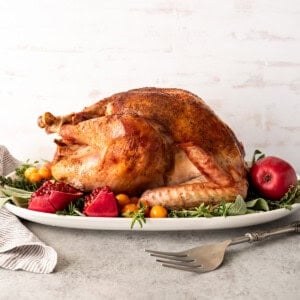I totally get why thousands of home cooks stress about cooking a turkey each year. It’s the centerpiece of our Thanksgiving tables and it feels like there is so much pressure for it to turn out perfectly! But it’s really not as bad as you might think. Especially with this easy, delicious bacon roasted Thanksgiving turkey recipe. Don’t miss any of our favorite Thanksgiving recipes, like the best sweet potato casserole of my life, this delicious turkey gravy, or our favorite cornbread stuffing! And of course you can’t forget the PIE!
How To Cook a Thanksgiving Turkey
This is not your typical butter & herb flavored turkey. I like roast turkey as much as the next person, but if I’m being totally honest, sometimes it gets a little boring and I want something different! So I made this bacon roasted Thanksgiving turkey with a simple but effective spice rub that would really enhance the flavor of the meat and make it different from the norm and definitely anything but bland. The salt and sugar in the rub help to not only flavor the turkey, but they also draw moisture out from the skin to help create a crispy brown crust. The smoked paprika, garlic, and pepper add depth of flavor and interest to the tender, juicy meat. And the fat from the bacon replaces the butter for imparting moisture and flavor to the turkey meat. Bacon makes everything more delicious, right? I’ve seen other bacon roasted turkey recipes, where you actually weave a lattice of bacon and wrap or lay it like a blanket over the turkey, but I think this approach of turning the bacon into a rub and putting it under the skin is even easier and more delicious because you actually get bacon flavor in every bite! While we typically brine our Thanksgiving turkey, I’ve found that by prepping and rubbing the turkey with this spice rub the day before Thanksgiving and leaving it uncovered in the fridge overnight, it helps the meat to absorb the rub flavor better and helps the turkey develop a wonderful, crispy, flavored skin, even without a brine. But by all means go ahead and combine both approaches by brining first if you have the space, time, and inclination for it.
How Much Turkey Per Person
Plan on 1 ¼ to 1 ½ pounds of turkey per person for Thanksgiving Dinner. That includes the weight of the skin and bones, since obviously most people won’t sit down to eat one pound of turkey meat! So a 12-pound turkey should feed approximately 8-10 people.
Purchasing a Fresh Turkey
If purchasing a fresh turkey, you will want to buy it 1-2 days before you plan to cook it, but no farther in advance. At some stores you can place an order for a fresh turkey in advance to reserve one.
How to Thaw a Frozen Turkey
We prefer to use a fresh turkey when possible, but sometimes fresh turkeys are hard to come by. The rule of thumb for thawing a frozen turkey is to allow it to thaw in its packaging in the fridge for 1 day for every 4 pounds of turkey. It definitely doesn’t hurt to give the turkey an extra day though, just to be on the safe side. So if you are planning to cook a 12-pound frozen turkey, let it thaw in the fridge for at least 3-4 days. I always place a baking sheet under the turkey to catch any liquid that might come off the turkey as it thaws. No one wants to clean up that mess!
Make the Turkey Rub
Start by combining a bunch of delicious spices in a bowl and mixing them together. Set aside two tablespoons of the rub for the outside of the turkey. Meanwhile, roughly chop the bacon, then transfer it to a food processor (affiliate link) along with the rest of the spice rub. Pulse 10-15 times until the bacon is finely chopped, almost to the point of turning it into a paste. This is what you are going to use under the skin of the turkey to provide flavor and fat that will make this bacon roasted turkey so memorable.
How to Prep the Turkey
First, remove the turkey from it’s packaging and pat it dry with paper towels. I never rinse my turkey because I don’t want to splatter germs all over the kitchen. Pull out the neck and giblets from the main cavity of the turkey and discard or save for making stuffing or gravy, which is what my mom always did. Pat the insides of the cavities dry as well. Season the cavities of the turkey with salt and pepper. I just pour the salt into my hand then rub it around so I would say it’s about a generous tablespoon of salt and half as much pepper. Then stuff them with aromatics like quartered onions, apples, lemons, celery, and sprigs of fresh herbs. Tuck the wing tips underneath the body of the turkey truss the legs by tying one end of a piece of twine around one leg, then crossing it over the other leg and tying the legs so they stay together while the turkey cooks. It makes for a more beautiful presentation and I hear it also helps keep the turkey moist, although I don’t know that trussing it makes that big of a difference in that regard. Loosen the skin on the turkey breasts by using your fingers to separate the breast meat from the skin like you are trying to squish your hand into a glove. Be gentle and use your fingers to wiggle and pry the skin loose. Then stuff your bacon & spice rub up under the skin and squish it around to cover the meat as much as possible. Then drizzle the turkey with a couple of tablespoons of olive oil, rub the skin, then sprinkle it with the remaining spice rub! Place the turkey in your roasting pan on top of a bed of roughly chopped vegetables like carrots, onions, and celery, and cover the breast meat with a foil shield. To do this, make a large triangle by folding a square of aluminum foil in half and molding it to the body of the turkey. This will be removed partway through the roasting process to allow the skin on the top of the turkey to brown.
How Long to Cook Turkey
Turkeys vary widely in size, so the time it takes to roast a turkey can be drastically different from one bird to the next. But the rule of thumb is to plan on 15 minutes for each 1 pound of turkey. So a 12-pound turkey will take approximately 3 hours to cook all the way through. About halfway through the cooking process, check on the turkey and remove the foil shield so the skin on top can brown. I like to baste the turkey every half an hour or so with the juices from the pan, but this step isn’t vital since the melting bacon fat will be doing that job for you.
How to Know When the Turkey is Done
The best and most reliable way to tell if your turkey is done is to always use a meat thermometer. Turkey should be cooked to 165° F when tested with a digital meat thermometer (affiliate link) inserted into the thickest part of the breast, but I remove it from the oven when it reaches 160° F because the temperature always continues to rise 5 degrees after the bird is removed from the oven. Be sure the thermometer is not touching the bone, which will give an inaccurate reading. If you are testing the thigh area, it should read 170° F.
Be Sure to Let the Turkey Rest
Once the turkey is done cooking, let it rest for at least 15-45 minutes before carving. Letting the meat rest is an important principle when cooking lots of different cuts of meat because it allows the juices to redistribute, resulting in better flavor and texture throughout the dish. The resting time also lets you use the oven to finish warming up side dishes or bake those fresh dinner rolls so they are piping hot when dinner is served!
Thanksgiving Turkey Tips & Tricks
My top tip? Don’t overcook your turkey! That’s what really dries it out more than anything. Buy a meat thermometer and use it. It makes life so much easier to just be able to stick a thermometer in and be confident that once you reach the right temperature, your turkey will be done. And use the foil shield so the breasts don’t over cook while you are trying to get the legs and thighs to finish. Your turkey needs salt. Rub it on the inside of the turkey cavity and make sure there is salt in your rub. You do not need to use a brine with this turkey recipe, but if you want to, then go for it. Brining a turkey helps prevent it from drying out and adds moisture and flavor to the finished bird. For more helpful tips on brining a turkey, be sure to check out my Turkey Brine Recipe post! Use a doubled-up piece of aluminum foil as a shield to cover the body of the turkey, leaving the legs exposed. Just tear off a large piece of foil and foil it in half to create a triangle, then mold that triangle around the turkey to create a hat for the breasts. This will go onto the turkey partway through the roasting process and allow the legs to cook longer without drying out the breast meat. I like to garnish my serving plate with a variety of herbs from the garden like rosemary, sage, and thyme, along with pieces of fruit, just for visual interest. You could also use kale for greens or whatever fruit you have on hand. Here I used gooseberries and pomegranates, but fresh cranberries are my other favorite garnish to decorate a serving plate with turkey on it. No need for an expensive roasting pan. Just grab a cheap disposable aluminum pan or use your largest baking dish like me and scatter large chunks of vegetables in the bottom to raise the turkey out of the juices while it cooks. Roughly chopped carrots, onion, celery, and apples work great for elevating the bird while it cooks in place of a wire rack.
More of Our Favorite Thanksgiving Recipes
Juicy Roast Turkey with a Butter Herb Rub Homemade Turkey Gravy Lion House Dinner Rolls (with Whipped Cinnamon Honey Butter!) Triple Layer Vintage Christmas Jell-O Salad Easy Homemade Cranberry Sauce Easy Southern Cornbread Dressing Slow Cooker Creamed Corn The BEST Homemade Mashed Potatoes! And let’s not overlook the PIE for dessert!
Best Green Bean Casserole
Sweet Potato Casserole with Marshmallows
Cranberry Jello Salad with Cream Cheese Topping
Let me know what you thought with a comment and rating below. You can also take a picture and tag me on Instagram @houseofnasheats or share it on the Pinterest pin so I can see.
